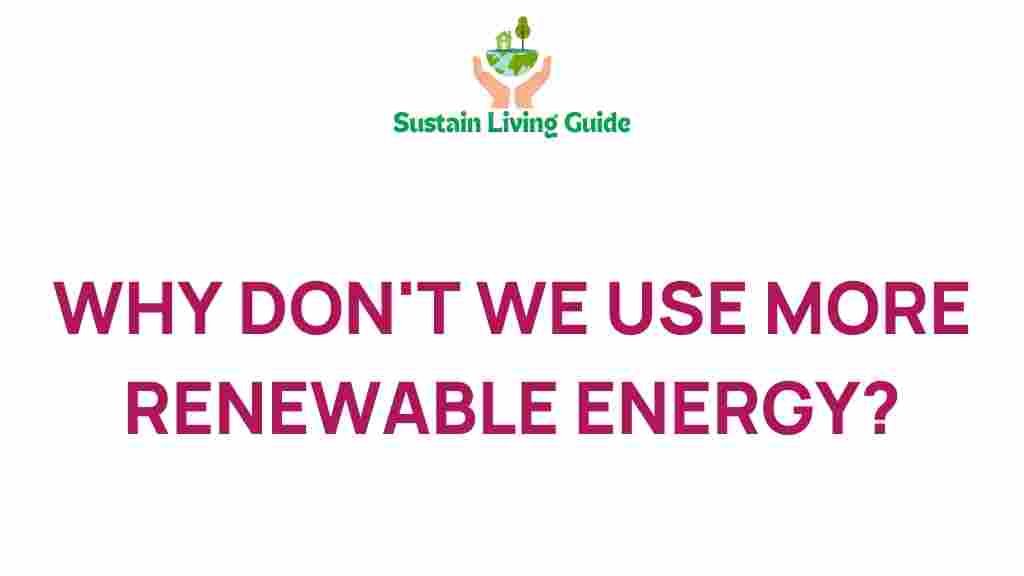Renewable Energy: The Key to a Sustainable Future
As the world grapples with the pressing issues of climate change and energy scarcity, the conversation around renewable energy has never been more critical. Despite its potential to provide a sustainable solution to our energy needs, the transition to renewable energy sources such as solar, wind, and hydroelectric power has been slower than expected. In this article, we will unravel the mystery behind why we aren’t harnessing more renewable energy and explore the barriers that stand in the way of a greener future.
Understanding Renewable Energy
Renewable energy refers to energy generated from natural resources that are replenished at a faster rate than they are consumed. The main types of renewable energy include:
- Solar Energy: Captured from sunlight using photovoltaic cells or solar panels.
- Wind Energy: Generated by converting the kinetic energy of wind into electricity using wind turbines.
- Hydroelectric Energy: Produced by harnessing the energy of flowing water, typically in dams.
- Geothermal Energy: Extracted from the heat stored beneath the Earth’s surface.
- Biomass Energy: Derived from organic materials, such as plant and animal waste.
Each of these sources has the potential to significantly reduce our reliance on fossil fuels, lower greenhouse gas emissions, and provide a sustainable energy future. However, despite these advantages, the rate of adoption remains alarmingly low.
Barriers to Harnessing More Renewable Energy
To fully understand why we aren’t harnessing more renewable energy, we must delve into the key barriers that hinder its adoption. These obstacles can be categorized into several areas:
1. Economic Challenges
The initial investment required for renewable energy projects can be substantial. For many countries, especially developing nations, the cost of implementing renewable technologies can deter action. Some specific economic challenges include:
- High Capital Costs: Setting up solar farms or wind turbines requires significant upfront capital.
- Subsidies for Fossil Fuels: Many governments still provide financial support for fossil fuel industries, making it harder for renewable energy to compete.
- Market Volatility: The fluctuating prices of renewable technologies can cause uncertainty for investors.
2. Technological Limitations
While technology in the renewable energy sector has advanced, there are still limitations that need to be addressed:
- Storage Solutions: Renewable energy sources like solar and wind are intermittent, requiring effective storage solutions to ensure a steady energy supply.
- Grid Infrastructure: Many existing electrical grids are not equipped to handle the decentralized nature of renewable energy.
- Technological Maturity: In some regions, renewable technologies are still in their infancy, leading to inefficiencies.
3. Political and Regulatory Issues
Government policies play a crucial role in shaping the future of renewable energy. However, inconsistencies and lack of support can hinder progress:
- Inconsistent Policies: Frequent changes in government can lead to a lack of continuity in renewable energy policies.
- Regulatory Hurdles: Complex regulations can slow down the development and implementation of renewable projects.
- Lack of Incentives: Without financial incentives, businesses may be reluctant to invest in renewable energy.
4. Social Acceptance and Awareness
Public perception can greatly influence the adoption of renewable energy technologies. Some challenges include:
- Awareness and Education: Many individuals lack a basic understanding of renewable energy and its benefits.
- NIMBYism (Not In My Backyard): Communities may oppose renewable projects due to concerns about aesthetics or local environmental impacts.
- Job Displacement Concerns: The transition to renewable energy can lead to fears of job losses in traditional fossil fuel industries.
Step-by-Step Process to Overcome Barriers
To increase the adoption of renewable energy, a structured approach is needed. Here is a step-by-step process that can be implemented by governments, businesses, and communities:
Step 1: Increase Investment in Renewable Technologies
Encouraging investments in renewable energy can be achieved through:
- Creating tax incentives for renewable energy projects.
- Offering grants and subsidies to offset initial costs.
- Establishing public-private partnerships to share financial risks.
Step 2: Improve Technological Infrastructure
Investing in technology is essential for the growth of renewable energy:
- Developing efficient energy storage systems.
- Modernizing grid infrastructure to handle renewable energy inputs.
- Investing in research and development for new renewable technologies.
Step 3: Foster Supportive Policies and Regulations
Governments should create a conducive environment for renewable energy:
- Implementing consistent and long-term renewable energy policies.
- Streamlining regulatory processes to expedite project approvals.
- Establishing renewable energy targets to drive action.
Step 4: Enhance Public Awareness and Education
Raising awareness about renewable energy is vital for its acceptance:
- Launching public awareness campaigns that highlight the benefits of renewable energy.
- Integrating renewable energy education into school curricula.
- Engaging communities in discussions about local renewable projects.
Troubleshooting Tips for Renewable Energy Projects
Despite the barriers, there are various strategies that can help navigate challenges in renewable energy projects:
Identify Funding Opportunities
Explore federal and state funding opportunities, as well as private grants to support renewable energy initiatives. Websites like Energy.gov can provide valuable resources.
Engage Stakeholders Early
Involve local communities, businesses, and government entities at the project’s inception to build trust and gather support.
Conduct Feasibility Studies
Before embarking on a renewable energy project, conduct thorough feasibility studies to assess the viability of the project in terms of technology, location, and market demand.
Monitor and Adapt
Regularly monitor the performance of renewable energy projects and be prepared to adapt strategies based on emerging technologies and market conditions.
Conclusion: The Path Forward
The journey toward harnessing more renewable energy is fraught with challenges, but it is one we must undertake for the sake of our planet and future generations. By addressing economic, technological, political, and social barriers, we can unlock the potential of renewable energy and create a sustainable energy landscape. It’s time for individuals, businesses, and governments to collaborate and take decisive actions that will lead us toward a greener, more sustainable future.
For more information on renewable energy initiatives, you can explore resources available at RenewableEnergyWorld.com.
This article is in the category Energy and created by SustainLivingGuide Team
